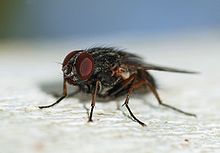| Muscina | |
|---|---|

| |
| Adult Muscina stabulans | |
| Scientific classification | |
| Domain: | Eukaryota |
| Kingdom: | Animalia |
| Phylum: | Arthropoda |
| Class: | Insecta |
| Order: | Diptera |
| Family: | Muscidae |
| Subfamily: | Azeliinae |
| Tribe: | Reinwardtiini |
| Genus: | Muscina Robineau-Desvoidy, 1830[1] |
| Type species | |
| M. stabulans | |
Muscina is a genus of flies that belongs to the family Muscidae, currently consisting of 27 species.[3] They are worldwide in distribution and are frequently found in livestock facilities and outside restrooms. The most common species are M. stabulans (the most widely studied species), M. levida, and M. prolapsa. Muscina flies commonly breed in manure and defecate on food, which has been linked to the spread of some disease and illnesses.[4][5] The occurrence of Muscina larvae on dead bodies has led to their regular use in forensic investigations, as they may be used to estimate the time of death.[6] Research have shown the prevalence of certain species of Muscina flies as vectors of diseases such as poliomyelitis.[7]
- ^ Robineau-Desvoidy, André Jean Baptiste (1830). "Essai sur les myodaires". Mémoires presentés à l'Institut des Sciences, Lettres et Arts, par divers savants et lus dans ses assemblées: Sciences, Mathématiques et Physique. 2 (2): 1–813. Retrieved 15 July 2018.
- ^ Coquillett, D.W. (1901). "Types of anthomyid genera". Journal of the New York Entomological Society. 9 (3): 134–146. JSTOR 25002949.
- ^ "ITIS Standard Report Page: Muscina." Integrated Taxonomic Information System. 20 Mar. 2009 <https://www.itis.gov/servlet/SingleRpt/SingleRpt?search_topic=TSN&search_value=150028>
- ^ "False Stable Fly." North Carolina IPM. 20 Mar. 2009 <http://ipm.ncsu.edu/AG369/notes/false_stable_fly.html>
- ^ "Fly Control In Confined Livestock And Poultry Production - Novartis Animal Health Inc." The Control Of Flies On Livestock And Poultry Farms - Novartis Animal Health Inc. 20 Mar. 2009
- ^ White, Richard E. (1998). A Field Guide to the Beetles of North America. New York, New York: Houghton Mifflin Harcourt. pp. 208–214. ISBN 978-0-395-91089-4.
- ^ Cite error: The named reference
poliowas invoked but never defined (see the help page).